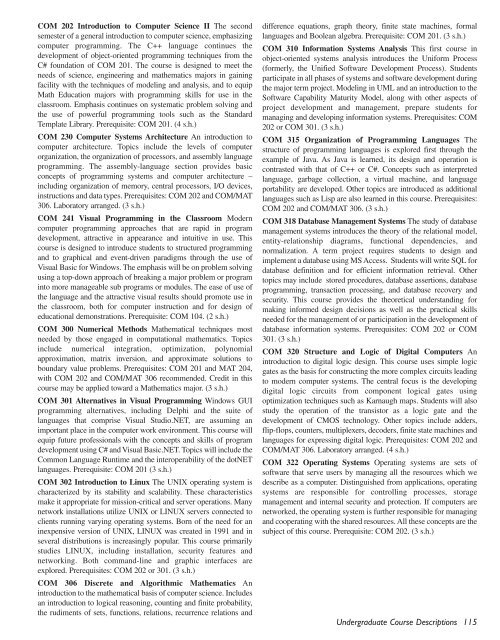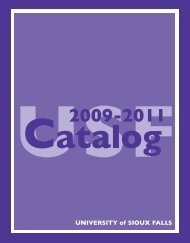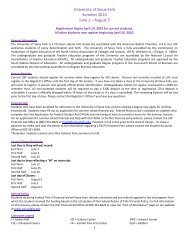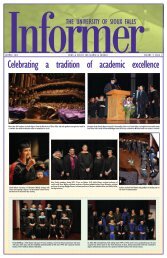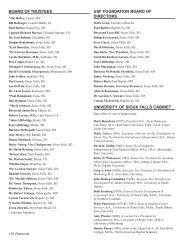USF TELEPHONE DIRECTORY - University of Sioux Falls
USF TELEPHONE DIRECTORY - University of Sioux Falls
USF TELEPHONE DIRECTORY - University of Sioux Falls
You also want an ePaper? Increase the reach of your titles
YUMPU automatically turns print PDFs into web optimized ePapers that Google loves.
COM 202 Introduction to Computer Science II The second<br />
semester <strong>of</strong> a general introduction to computer science, emphasizing<br />
computer programming. The C++ language continues the<br />
development <strong>of</strong> object-oriented programming techniques from the<br />
C# foundation <strong>of</strong> COM 201. The course is designed to meet the<br />
needs <strong>of</strong> science, engineering and mathematics majors in gaining<br />
facility with the techniques <strong>of</strong> modeling and analysis, and to equip<br />
Math Education majors with programming skills for use in the<br />
classroom. Emphasis continues on systematic problem solving and<br />
the use <strong>of</strong> powerful programming tools such as the Standard<br />
Template Library. Prerequisite: COM 201. (4 s.h.)<br />
COM 230 Computer Systems Architecture An introduction to<br />
computer architecture. Topics include the levels <strong>of</strong> computer<br />
organization, the organization <strong>of</strong> processors, and assembly language<br />
programming. The assembly-language section provides basic<br />
concepts <strong>of</strong> programming systems and computer architecture –<br />
including organization <strong>of</strong> memory, central processors, I/O devices,<br />
instructions and data types. Prerequisites: COM 202 and COM/MAT<br />
306. Laboratory arranged. (3 s.h.)<br />
COM 241 Visual Programming in the Classroom Modern<br />
computer programming approaches that are rapid in program<br />
development, attractive in appearance and intuitive in use. This<br />
course is designed to introduce students to structured programming<br />
and to graphical and event-driven paradigms through the use <strong>of</strong><br />
Visual Basic for Windows. The emphasis will be on problem solving<br />
using a top-down approach <strong>of</strong> breaking a major problem or program<br />
into more manageable sub programs or modules. The ease <strong>of</strong> use <strong>of</strong><br />
the language and the attractive visual results should promote use in<br />
the classroom, both for computer instruction and for design <strong>of</strong><br />
educational demonstrations. Prerequisite: COM 104. (2 s.h.)<br />
COM 300 Numerical Methods Mathematical techniques most<br />
needed by those engaged in computational mathematics. Topics<br />
include numerical integration, optimization, polynomial<br />
approximation, matrix inversion, and approximate solutions to<br />
boundary value problems. Prerequisites: COM 201 and MAT 204,<br />
with COM 202 and COM/MAT 306 recommended. Credit in this<br />
course may be applied toward a Mathematics major. (3 s.h.)<br />
COM 301 Alternatives in Visual Programming Windows GUI<br />
programming alternatives, including Delphi and the suite <strong>of</strong><br />
languages that comprise Visual Studio.NET, are assuming an<br />
important place in the computer work environment. This course will<br />
equip future pr<strong>of</strong>essionals with the concepts and skills <strong>of</strong> program<br />
development using C# and Visual Basic.NET. Topics will include the<br />
Common Language Runtime and the interoperability <strong>of</strong> the dotNET<br />
languages. Prerequisite: COM 201 (3 s.h.)<br />
COM 302 Introduction to Linux The UNIX operating system is<br />
characterized by its stability and scalability. These characteristics<br />
make it appropriate for mission-critical and server operations. Many<br />
network installations utilize UNIX or LINUX servers connected to<br />
clients running varying operating systems. Born <strong>of</strong> the need for an<br />
inexpensive version <strong>of</strong> UNIX, LINUX was created in 1991 and in<br />
several distributions is increasingly popular. This course primarily<br />
studies LINUX, including installation, security features and<br />
networking. Both command-line and graphic interfaces are<br />
explored. Prerequisites: COM 202 or 301. (3 s.h.)<br />
COM 306 Discrete and Algorithmic Mathematics An<br />
introduction to the mathematical basis <strong>of</strong> computer science. Includes<br />
an introduction to logical reasoning, counting and finite probability,<br />
the rudiments <strong>of</strong> sets, functions, relations, recurrence relations and<br />
difference equations, graph theory, finite state machines, formal<br />
languages and Boolean algebra. Prerequisite: COM 201. (3 s.h.)<br />
COM 310 Information Systems Analysis This first course in<br />
object-oriented systems analysis introduces the Uniform Process<br />
(formerly, the Unified S<strong>of</strong>tware Development Process). Students<br />
participate in all phases <strong>of</strong> systems and s<strong>of</strong>tware development during<br />
the major term project. Modeling in UML and an introduction to the<br />
S<strong>of</strong>tware Capability Maturity Model, along with other aspects <strong>of</strong><br />
project development and management, prepare students for<br />
managing and developing information systems. Prerequisites: COM<br />
202 or COM 301. (3 s.h.)<br />
COM 315 Organization <strong>of</strong> Programming Languages The<br />
structure <strong>of</strong> programming languages is explored first through the<br />
example <strong>of</strong> Java. As Java is learned, its design and operation is<br />
contrasted with that <strong>of</strong> C++ or C#. Concepts such as interpreted<br />
language, garbage collection, a virtual machine, and language<br />
portability are developed. Other topics are introduced as additional<br />
languages such as Lisp are also learned in this course. Prerequisites:<br />
COM 202 and COM/MAT 306. (3 s.h.)<br />
COM 318 Database Management Systems The study <strong>of</strong> database<br />
management systems introduces the theory <strong>of</strong> the relational model,<br />
entity-relationship diagrams, functional dependencies, and<br />
normalization. A term project requires students to design and<br />
implement a database using MS Access. Students will write SQL for<br />
database definition and for efficient information retrieval. Other<br />
topics may include stored procedures, database assertions, database<br />
programming, transaction processing, and database recovery and<br />
security. This course provides the theoretical understanding for<br />
making informed design decisions as well as the practical skills<br />
needed for the management <strong>of</strong> or participation in the development <strong>of</strong><br />
database information systems. Prerequisites: COM 202 or COM<br />
301. (3 s.h.)<br />
COM 320 Structure and Logic <strong>of</strong> Digital Computers An<br />
introduction to digital logic design. This course uses simple logic<br />
gates as the basis for constructing the more complex circuits leading<br />
to modern computer systems. The central focus is the developing<br />
digital logic circuits from component logical gates using<br />
optimization techniques such as Karnaugh maps. Students will also<br />
study the operation <strong>of</strong> the transistor as a logic gate and the<br />
development <strong>of</strong> CMOS technology. Other topics include adders,<br />
flip-flops, counters, multiplexers, decoders, finite state machines and<br />
languages for expressing digital logic. Prerequisites: COM 202 and<br />
COM/MAT 306. Laboratory arranged. (4 s.h.)<br />
COM 322 Operating Systems Operating systems are sets <strong>of</strong><br />
s<strong>of</strong>tware that serve users by managing all the resources which we<br />
describe as a computer. Distinguished from applications, operating<br />
systems are responsible for controlling processes, storage<br />
management and internal security and protection. If computers are<br />
networked, the operating system is further responsible for managing<br />
and cooperating with the shared resources. All these concepts are the<br />
subject <strong>of</strong> this course. Prerequisite: COM 202. (3 s.h.)<br />
Undergraduate Course Descriptions<br />
115


